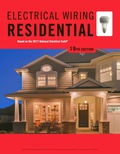
EBK ELECTRICAL WIRING RESIDENTIAL
19th Edition
ISBN: 9781337516549
Author: Simmons
Publisher: CENGAGE LEARNING - CONSIGNMENT
expand_more
expand_more
format_list_bulleted
Concept explainers
Question
Chapter 3, Problem 13R
To determine
Find the smallest size wire used in a branch circuit rated at 20 amperes.
Expert Solution & Answer
Trending nowThis is a popular solution!

Students have asked these similar questions
help on this one?
a 1. What is the transpose system. What is the advantage of it.
2. What is the intersheath grading. What is the advantage of it.
3. What is the difference between redial and ring distribution system.
Please show all the steps!
Chapter 3 Solutions
EBK ELECTRICAL WIRING RESIDENTIAL
Ch. 3 - Prob. 1RCh. 3 - How are branch circuits rated? See NEC 210.3._____Ch. 3 - Prob. 3RCh. 3 - Prob. 4RCh. 3 - What spaces are not included in the floor area...Ch. 3 - What is the unit load per square foot for dwelling...Ch. 3 - According to NEC 210.50(C), a laundry equipment...Ch. 3 - How is the total load in volt-amperes for lighting...Ch. 3 - How is the total lighting load in amperes...Ch. 3 - How is the required number of branch circuits...
Ch. 3 - What is the minimum number of 15-ampere lighting...Ch. 3 - How many lighting branch circuits are provided in...Ch. 3 - Prob. 13RCh. 3 - How is the load determined for outlets supplying...Ch. 3 - What type of circuits must be provided for...Ch. 3 - Prob. 16RCh. 3 - In a single-family dwelling, how is overcurrent...Ch. 3 - Prob. 18RCh. 3 - The minimum number of outdoor receptacles for a...Ch. 3 - The Code indicates the rooms in a dwelling that...Ch. 3 - Prob. 21RCh. 3 - Prob. 22RCh. 3 - Prob. 23RCh. 3 - Prob. 24RCh. 3 - Prob. 25RCh. 3 - Although the Code contains many exceptions to the...Ch. 3 - The rating of a branch circuit is based on (Circle...Ch. 3 - a. A 25-ampere branch-circuit conductor is derated...Ch. 3 - Prob. 29RCh. 3 - Prob. 30RCh. 3 - Prob. 31RCh. 3 - Prob. 32RCh. 3 - A split-level home has one stairway that has six...Ch. 3 - Prob. 34RCh. 3 - Prob. 35RCh. 3 - Prob. 36RCh. 3 - In the past, it was common practice to connect the...Ch. 3 - If a residence has two bathrooms, the Code states:...Ch. 3 - Prob. 39RCh. 3 - Prob. 40RCh. 3 - Prob. 41RCh. 3 - Prob. 42RCh. 3 - Prob. 43R
Knowledge Booster
Learn more about
Need a deep-dive on the concept behind this application? Look no further. Learn more about this topic, electrical-engineering and related others by exploring similar questions and additional content below.Similar questions
- Please show all the steps!arrow_forward10-3) similar to Lathi & Ding, Prob. P.6.3-7 The Fourier transform P(f) of a the basic pulse p(t) used in a certain binary communication is shown in the figure below: P(f) 1 0.5 0 f₁ = 0.8 √₂ = 1.2 f, MHz (a) From the shape of P(f), explain at what pulse rate this pulse would satisfy Nyquist's first criterion. (b) Assuming that the pulse is a raised-cosine pulse, find its rolloff factor. (c) Find p(t) and verify that this pulse satisfies Nyquist's first criterion in the time domain. (d) Show how rapidly the pulse decays as a function of t, (i.e., what power of t does the envelope obey for large time values).arrow_forwardDon't use ai to answer I will report you answerarrow_forward
- Don't use ai to answer I will report you answerarrow_forwardDon't use ai to answer I will report you answerarrow_forwardChoose the correct answer for from the following sentences: 1. The purpose of the microprocessor is to control b. memory c. processing d. tasks a. switches 2. Which of the following instructions represents base-plus-index addressing mode? a. MOV AL,[BX] b. MOV AL,[SI] c. MOV AL,BX d. MOV AL,[BX+SI] 3. The BIU pre-fetches the instruction from memory and store them in b. memory c. stack d. queue a. register 4. Which function is used to control the PWM (Pulse Width Modulation) on the Arduino output pin? a. digitalRead() b. analogRead() c. digitalWrite() 5. Which port in the PIC16F877A has an 8 external interrupt inputs? a. Port-A b. Port-C c. Port-B d. analogWrite() d. Port-D d. 4KByte 6. How much Flash EEPROM memory program found in the PIC16F877A microcontroller? a. 32KByte b. 16KByte c. 8KBytearrow_forward
- Solve and select the correct answer: 2. For a random variable X with pdf: p(x) value of x is = 119 10 for -5≤x≤5. The mean (a) -75 (b) 10 (c) 0 (d) 75 3. Is the matrix A = = [1] orthogonal? Find the rank of A? 0 (a) YES, -1 (b) NO, 2 (c) YES, 2 (d) NO, -1 4. L{et sin(3t)u(t)) = (a) s-3 (s-2)²+9 2 (b) (5-3)² (c) (s-3)²+4 S-2 3 (s-2)²+9 (d) (5-2)²+9 = 5. Given that x is a constant. Choose all the correct solutions for [∞ (AB)] = (a) (AB)T (b) x ATBT (c) α BTAT (d) x (AB)Tarrow_forwardDO NOT WANT AI WILL REJECTarrow_forward3. Roughly sketch the root locus for the following locations of open-loop poles and zeros. You just need to show the shape of the root locus; you do not calculate the asymptote, break-in, and break-away points. ☑ (a) (b) ☑ Φ ① $3 (c)arrow_forward
arrow_back_ios
SEE MORE QUESTIONS
arrow_forward_ios
Recommended textbooks for you
 EBK ELECTRICAL WIRING RESIDENTIALElectrical EngineeringISBN:9781337516549Author:SimmonsPublisher:CENGAGE LEARNING - CONSIGNMENT
EBK ELECTRICAL WIRING RESIDENTIALElectrical EngineeringISBN:9781337516549Author:SimmonsPublisher:CENGAGE LEARNING - CONSIGNMENT

EBK ELECTRICAL WIRING RESIDENTIAL
Electrical Engineering
ISBN:9781337516549
Author:Simmons
Publisher:CENGAGE LEARNING - CONSIGNMENT